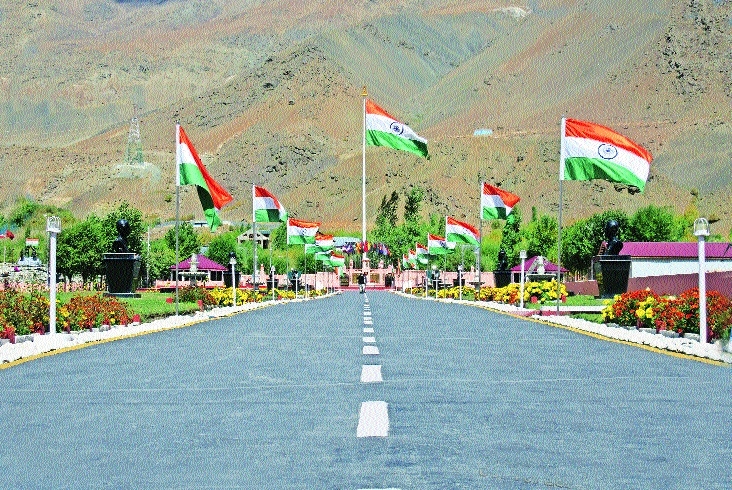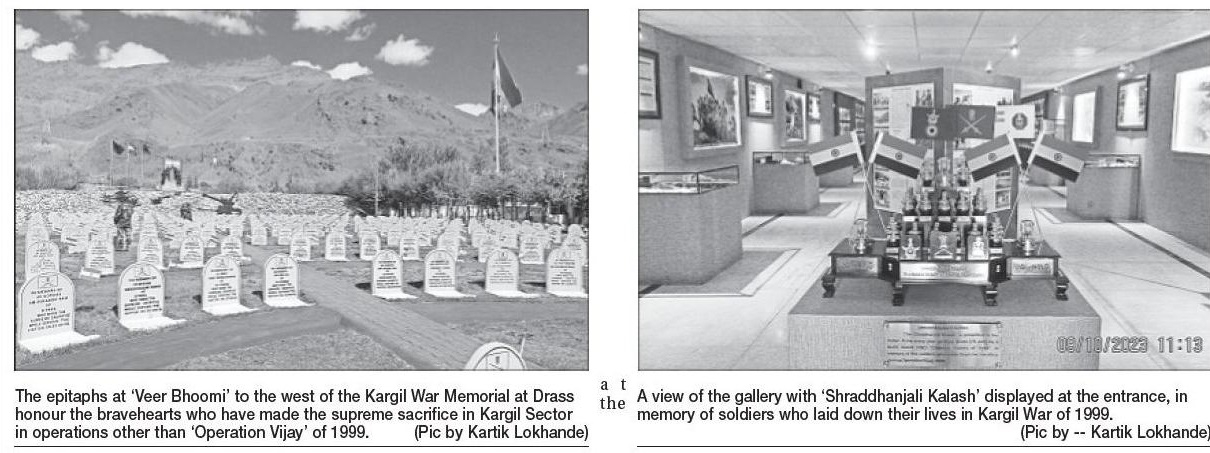Drass : Here tales of bravehearts are cast in stone, emotions
| Date :16-Nov-2023 |

A view of the Kargil War Memorial at Drass. The road leading to the memorial is aptly named ‘Vijaypath’. (Pic by Kartik Lokhande)
By Kartik Lokhande :
Dateline Kargil-11
The Drass War Memorial complex also has
memorials built to honour the
soldiers who made the supreme
sacrifice in Kargil Sector in all
operations since
1947-48, other than ‘Operation Vijay’ of 1999.
Where the cold winds blow, Gently with respect; Where the high mountains glow, Snowly and variegate; There, my dear countrymen, Rest the bravehearts, Hailing the motherland, Singing the song of sacrifice!
When one visits Drass, which is the second coldest inhabited place on Earth, one feels cold. But, as one visits the Kargil War Memorial, one feels the gush of blood and warmth. For, here lay the bravehearts of India who made the supreme sacrifice to defend their motherland from the repeated attacks by Pakistan.
Though there are memorials, small and big, commemorating the heroic deeds of the Indian soldiers in the 1999 Kargil war with Pakistan, the most important one is built near the village of Bimbat (also spelt as Bhimbat) in Drass.

It is also known as Drass War Memorial. If one wishes to know details about the Kargil war of 1999, martyrs, major actions, roles played by the Indian Army, the Indian Air Force, the Indian Navy, and also about those who became martyrs while serving in Kargil Sector since Indian independence from the British, the Drass War Memorial is the must-visit place. After the Kargil War of 1999 was over, the Indian Army thought of constructing a memorial in the area of operations of 8 Mountain Division. The idea was to keep alive the memories of those who fought and made the supreme sacrifice in service of the motherland, at the desolate heights. The major motive was to inspire the younger generation, who would visit the place. As per the records, Maj Gen Mohinder Puri, who commanded 8 Mountain Division, during 1999 war, conceived the idea of the memorial. After exploration of various sites, finally the site at Bimbat was chosen as it is a wide open valley surrounded by snow-clad mountains. Besides, it was closer to the important features like Tololing, Mashkoh Valley, Tiger Hill, which had seen intense action during the war.
Accordingly, the memorial was constructed.
The main memorial stands over a square platform. The
platform and pedestal are made of local stones cut and polished by local artisans at Kargil. Lt Gen Arjun Ray, General Officer Commanding, 14 Corps, inaugurated the memorial on July 26, 2000, that is, the first anniversary of India’s victory in Kargil war. As per the records, around 1,000 people including the residents of Drass, Bimbat, and Mashkoh attended the ceremony.
Gradually, several value additions were made to develop the memorial located along Srinagar-Leh highway. Every year, a glittering function to mark the Kargil Vijay Diwas is organised on July 26 at this memorial to pay tributes to the brave Indian soldiers. In the evening, several candles are lit -- one each for the Kargil war martyrs -- at the memorial. The dominating peaks including Tiger Hill and Tololing are illuminated with torches, presenting a haloed view of the battlefield. Cultural and other programmes are organised every year, which are attended by the Indian Armed Forces officers and personnel, civilians, war heroes, and the next of kin of the martyrs.
Today, Drass War Memorial has become a major tourist attraction. In fact, thanks to the Kargil Vijay Diwas celebration every year and boost to tourism, several hotels and homestays and eating joints have come up in Drass and even in Bimbat.
The Kargil War Memorial complex at Drass has several salient features. The road leading from the entrance gate to the main memorial is named ‘Vijay Path’. It is lined with national tricolours on either sides and eight busts of Param Vir Chakra and Maha Vir Chakra awardees (who were awarded the gallantry awards posthumously in recognition of their daredevil acts that helped India win the war). A giant national flag flies high at the memorial. The ambience instantly has its impact on the visitors. The central feature of the memorial is a cenotaph carved in pink sand stone, and ‘Amar Jawan Jyoti’ at its base. The cenotaph is surrounded by four minarets, and also has an inscription of an extract from the poem ‘Pushp Ki Abhilasha’ by noted poet Makhanlal Chaturvedi.
The ‘Wall of Fame’ forms the perfect background of the cenotaph. It is a brass wall, engraved with names of 559 bravehearts who laid down their lives during ‘Operation Vijay’ to flush out Pakistani intruders. As 2024 will see the Silver Jubilee celebrations of Kargil Vijay Diwas on July 26, preparations are afoot to provide more finesse to everything. The engraved names on brass wall are being painted.
The wall has names of 33 officers, 23 Junior Commissioned Officers, 501 Other Ranks, and two civilians. Also, the formation signs of 8 Mountain Division and 3 Infantry Division are on top of the wall. The lines of Hindi poem ‘Shaheedon ki Cheetaon Par...’ by Jagdamba Prasad Mishra are inscribed at the memorial.
The Indian Army soldiers, who brief the visitors about the memorial, begin their narration in clear voice with ‘Shaheedon ki Cheetaon Par...’. They narrate the story with change in tone of voice while describing the incidents of valour, emotions, and sacrifice, and have their effect on the listeners.
In the memorial complex, there is a ‘Hut of Remembrance’. It was inaugurated on July 25, 2009, by Gen V P Malik, who was the Chief of Army Staff during the Kargil War. Later on, the hut was named after Captain Manoj Kumar Pandey, the Param Vir Chakra (posthumous) awardee. It has photographs from the war time, concise accounts of various battles, contribution of various units, photo gallery of PVC and Maha Vir Chakra awardees, models of battles of Tololing, Tiger Hill, Pt 4875, and Khalubar Ridge. Also, it exhibits the weapons seized from Pakistani intruders and documents exposing the Pakistani lie that its regular soldiers were not involved in the Kargil war. The Pakistani flag is depicted upside down, as it was defeated by India. The Pakistani flag is displayed in similar fashion on the huts seized from enemy-held positions. The Drass War Memorial complex also has memorials built to honour the soldiers who made the supreme sacrifice in Kargil Sector in all operations since 1947-48, other than ‘Operation Vijay’ of 1999. Even the visiting soldiers serving in the sector today are overwhelmed while going through the names on the epitaphs.
The epitaphs in ‘Veer Bhoomi’ have names of such soldiers. There is a Zojila War Memorial too next to ‘Veer Bhoomi’. It has plaques on which are inscribed the details of ‘Operation Bison’ and pays tributes to various units that participated in the 1947-48 action.
There is a helipad named after Capt Vijayant Thapar, who was awarded Vir Chakra posthumously. The helipad was in use during ‘Operation Vijay’ after capture of Tololing heights, for logistics, casualty evacuation and reconnaissance missions. It has been enlarged and resurfaced in 2021. The memorial complex also displays a Mig-21, presented in the year 2013 by 17 Squadron located at Bathinda, to commemorate the contribution of the Indian Air Force and as a tribute to Sqn Ldr Ajay Ahuja, who was awarded Vir Chakra posthumously.
An interesting part of the complex is ‘Down Memory Lane’ underground gallery, which was created in 2019. It showcases miniature model depicting the entire area of ‘Operation Vijay’ through models of seven important battles. Currently, the models are being modified for better and lively presentation with the help of different lighting arrangement, miniatures of soldiers making the steep climb, and narration accordingly.
Every visitor is shown a continuously playing show of Kargil war in the small theatre in the memorial complex. After going through all these, naturally, every visitor feels overwhelmed by emotions. Someone’s eyes well up, someone’s throat is choked with emotions, and someone’s heart is filled with utmost pride for the nation. One can find a reflection of all these emotions in the ‘Wall of Gratitude’ where visitors stick small signed chits, expressing their emotions in brief.
Obviously, the most dominant expression is plain and simple, but firm, “Jai Hind!”
(To be concluded)